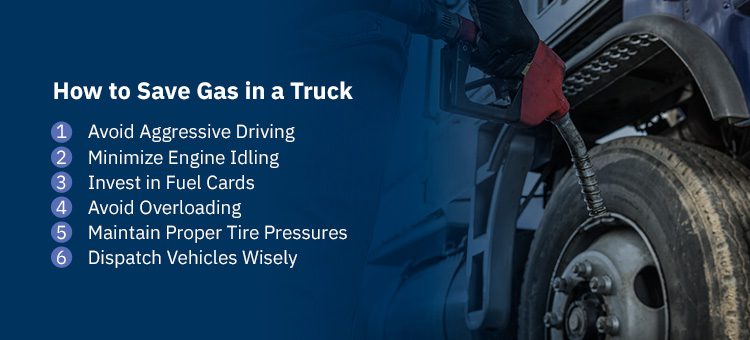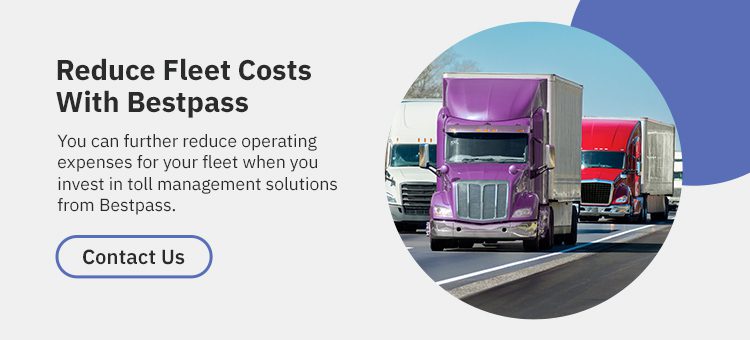
Optimizing Fleet Routes and Reducing Fuel Expenses
Fuel costs make up 60% or more of total operating expenses for heavy-duty truck fleets. Unfortunately, diesel fuel prices have only continued to grow, increasing by $1.66 from 2021 to 2022. As a result, many trucking fleets have begun struggling to manage these expenses on top of their additional operating costs.
Despite the rise in gas prices, there are multiple ways you can reduce fleet fuel costs for your trucking company. This guide discusses fleet fuel savings and route optimization techniques you can implement into your everyday practices to save the most money for your trucking company.
How to Optimize Trucking Routes
Arguably the best way to minimize your fleet’s fuel costs is by optimizing your trucking routes. Trucking route optimization is the process of determining the most efficient and cost-effective travel courses for your vehicles. This technique considers factors like fuel costs, tolls, stops, vehicle capacity, distance and customer demands.
There are various fleet route optimization tactics you can implement into your operations to save more money for your organization:
1. Fixed Routing
Fixed routing, also known as standard or static routing, is a strategy whereby each truck follows the same route with the same stops every day. Adhering to a fixed-routing schedule is an excellent option for companies with a customer base that remains mostly the same from week to week.
Note that while this technique can be effective when executed consistently, its unpredictable and inflexible nature can pose difficulties for drivers, limiting their ability to respond to any unexpected changes.
2. Dynamic Routing
Through dynamic routing, drivers plan new routes and stops every day, basing their decisions on that day’s circumstances, such as order quantities, customer demands and traffic. Dynamic routing is a popular choice for trucking fleets due to its flexibility, allowing drivers to adjust their routes at any point. That means if any unforeseen incidents or last-minute changes occur, they can restructure their routes in the moment, allowing them to leverage optimal alternatives.
3. Real-Time Dynamic Routing
This technique is similar to dynamic routing in that it involves route adaptations in response to sudden changes. However, through real-time dynamic routing, companies focus on constantly modifying their routes based on consecutive daily orders.
As businesses receive new orders or service requests throughout the day, they add them to the trucking route in logistical order to increase delivery speeds while minimizing run-around times. Real-time dynamic routing uses complex algorithms to identify and analyze the best routes at a given time.
4. Fleet Management Software
Route optimization software determines the best possible fleet routes for truck drivers by accounting for customer orders, road networks, resource availability and operational constraints. By analyzing these elements and planning routes accordingly, route optimization technologies can identify the fastest and most economical pathways for trucking fleets.
Fleet management software takes the complexity and tediousness out of route planning by using automation and high-accuracy algorithms to streamline this process. As a result, drivers can improve their delivery productivity, revenue and cost savings while meeting customer service requirements.
Some of the many innovative features of fleet optimization platforms include:
- Real-time monitoring
- Reports and alerts
- Process mapping
- Data analyses
- Delivery tracking metrics
- Mobile capabilities

How to Save Gas in a Truck
Even when gas prices are high, your drivers still have to drive. However, that doesn’t mean your company is fated to incur exorbitant fueling expenses. Luckily, there are many fuel fleet management strategies you can utilize to reduce your company’s costs.
1. Avoid Aggressive Driving
Though aggressive driving habits like rapid acceleration, weaving through traffic, sudden braking and speeding may seem inconsequential, they can dramatically increase fuel consumption. Aggressive driving has been shown to lower gas mileage by 15% to 30% on the highway and 10% to 40% in stop-and-go traffic, resulting in losses of 25 cents to $1 per gallon.
Improve fuel efficiency and road safety by training your drivers to avoid aggressive driving behaviors.
2. Minimize Engine Idling
Allowing your trucks to idle can cost your company considerably. Idling can waste between a quarter and a half-gallon of fuel per hour, costing companies up to three cents per minute. You can reduce fuel consumption and spend significantly by encouraging your drivers to turn off the engine during waiting times.
You can also minimize idling by planning to make deliveries during off-peak hours when traffic is light, such as in the mornings or late evenings. Avoiding rush-hour traffic means reducing stop-and-go driving and, subsequently, idling.
3. Invest in Fuel Cards
Fuel cards are designed to help trucking companies track and optimize their fuel spend. These programs offer fuel discounts from certain suppliers and help drivers pinpoint fuel stations with the lowest prices. Fuel cards also allow companies to track fleet transactions, helping them monitor and better understand how much their drivers are spending and make changes accordingly.
4. Avoid Overloading
While maximizing the amount of cargo on your trucks might seem like a best practice for your fleet, it can actually cost you. Every 100 pounds you add to your vehicle can cause a 1% decrease in miles-per-gallon (MPG), costing you 4 cents per gallon.
While this amount may seem insignificant, these expenses can add up as your trucks travel hundreds to thousands of miles per year. That’s why you should never load more than is necessary for each trip.
5. Maintain Proper Tire Pressures
Your tires play a major role in your company’s fuel consumption. According to the National Highway Traffic Safety Administration (NHTSA), proper tire inflation can save you up to 11 cents per gallon. On the other hand, both over- and under-inflated tires can significantly lower a vehicle’s gas mileage.
You can reduce your fleet’s fuel costs by requiring your drivers to perform regular tire pressure checks to ensure they’re filled to their recommended pressures at all times.
6. Dispatch Vehicles Wisely
You should pay mind to which drivers you dispatch to perform services and deliveries on the road. You can lower fuel consumption by assigning tasks based on which drivers are closest to the service or delivery location. That way, none of your trucks have to go out of their way to perform a job, saving you money on gas.
Determine the closest vehicles using automated fleet management software or by training a human dispatcher to send drivers to destinations with proximity in mind.


